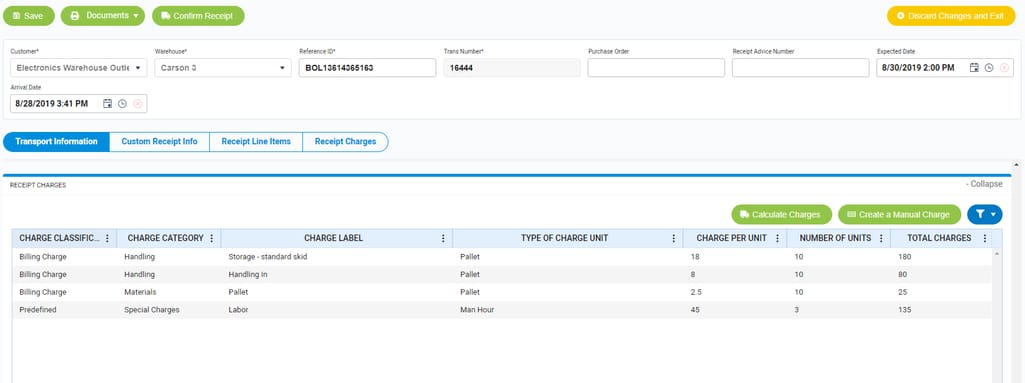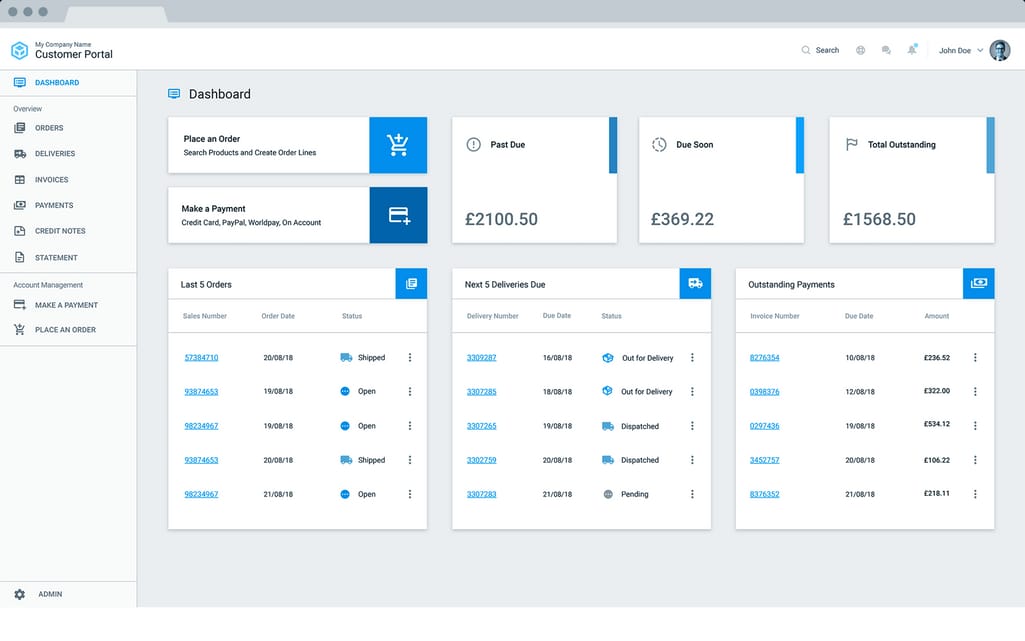Third-party logistics providers, or 3PLs, offer a wide range of services including transportation (global and local), warehousing (storage, picking, and packing), distribution and returns management, and so on. Given such diversity, the billing process becomes a serious challenge, especially considering the ever-fluctuating rates, assorted billing methods, and varying agreements. In addition, if you are a 3PL business owner or executive manager, you also have to think about maximizing the company revenue and customer satisfaction!
Well, no wonder that you’re probably looking for ways to streamline billing and invoicing. Let’s talk about how to make your life easier. In this article, we’ll describe the tricky process of billing and related challenges, explore how software solutions can help you with this business aspect, and offer a few implementation tips.
Note that here we’ll focus mostly on the billing of warehousing services rather than transportation since in many cases 3PL companies outsource delivery or partner with parcel couriers.
3PL billing process
So, let’s start with an overview of the standard 3PL billing process that you likely deal with regularly.
Key stages of the 3PL billing process
Signing a contract. First, you set up a billing agreement with a customer, outlining all the details, such as billing frequency, services provided, rates, special conditions, payment methods, etc. Consult Section 7 of the Uniform Commercial Code for legal rights and obligations and check the International Warehouse Logistics Association (IWLA) for industry standards regarding contract terms and billing practices.
Collecting transactional data. Once you’ve provided the services specified in the contract, you collect information about all the operations performed that are related to that customer, i.e., time and labor reports, work orders, purchase order receipts, order shipment reports, materials reports, and so on. If you offer value-added services, you obviously include them as well.
Making calculations. Depending on the billing agreements, you choose the services that have to be billed and calculate the charged amount. Some services such as storage can be charged monthly, while others (like picking and packing) are most likely to be charged per item.
Generating an invoice. Finally, you list all the charges in an invoice and send it to your customer.
Before we proceed to the problems associated with the billing process, let’s say a few words about the main fee categories that you can include in your invoice.
Types of fees
It’s up to you how to charge your customers. You can roll all the costs together into one flat fee or charge per each activity. In any case, here’s what you should consider including in your calculation.
- Set up fees -- some 3PLs charge a one-time installation fee for building an integration with the client’s software, training customer staff to work with their system, and so on.
- Recurring fees -- you can set up a flat fee that would be charged every billing cycle, e.g., for maintenance.
- Receiving (inbound) fees -- these are charged for receiving your customers’ goods and allocating them to your warehouse. You can either charge an hourly rate per number of workers involved or set a flat rate per item/pallet/order.
- Storage fees -- in most cases, these are calculated by the volume of space occupied per day or month. If your customer requires a lot of room, you can bill for occupancy by the entire section or zone. You can also charge by item or by pallet. Typically, there are larger storage fees for certain categories such as oversized items, goods that are classified as dangerous, extra-long storage (more than 365 days), and so on.
- Fulfillment (outbound) fees -- this group includes all the fees associated with handling and shipping your customers’ orders. Again, you can establish a flat fulfillment rate or charge separately for picking, packing, creating shipping labels, and packing materials used.
- Shipment/transportation fees -- since you either outsource the actual delivery to third-party service providers or use your own fleet, these charges will depend on your business model. They are typically included in the fulfillment group.
- Return fees -- if you process your customer’s returns, it makes sense to charge for return shipping and restocking.
- Custom or ad hoc fees -- these may include charges for any value-added or other additional services you agree on with your customer, such as door-to-door delivery, branding packages, kitting, and so on.
As an example, Amazon with its popular service Fulfillment by Amazon (FBA) charges storage fees monthly based on the daily average volume that the seller’s items occupy in their warehouse. Not surprisingly, fees for the holiday season (October through December) are about three times higher than for the rest of the year.
FBA’s fulfillment fees depend on the product category, weight, and dimensions and are charged per unit (additional fees apply to dangerous goods and for long-term storage). These include picking, packing, and shipping items, customer service, and handling returns.
Main billing challenges
When it comes to money, you want to be extra careful and avoid even the smallest mistakes. Unfortunately, when you get swamped with paperwork in an effort to connect all the dots, there’s no way you can prevent inaccuracies from sneaking in. Here are the main reasons your billing process can be such a pain in the neck.
Main 3PL billing challenges
Disconnected data
What happens in the warehouse stays in the warehouse (or was it said about something else?) There are thousands of operations being performed in storage facilities every day and if you don’t have a reliable connection between your warehousing and invoicing systems to track and record every single activity, you’re more than likely to miss something. Of course, the operations that are left unnoticed are left unbilled. And that means lost revenue which is not what you want, is it?
Different customer agreements
All customers are different (duh...) and often you have to offer a personalized approach to make them choose you over your competitors. That results in providing custom rates, creating unique arrangements, suggesting special discounts -- and then causes confusion when it comes to generating individual invoices.
Lack of visibility for customers
How often do you hear “Why were we billed for this?” or “What’s this bill for?” from a client? Customers always want to know exactly what they are paying for. When your invoicing is done manually or with the help of legacy systems, you’re not able to provide the necessary details, clearly break down your rate quotes, or even vouch for the accuracy of the figures. Wouldn’t it be great if you didn’t have to explain and verify every single line of the invoice?
Human errors
Well, this issue is pretty obvious, considering all the invoicing difficulties we mentioned. If you do your calculations in Excel spreadsheets or, God forbid, on paper, the risk of mistakes is too high. And that leads to either customer dissatisfaction with extra charges or your losses if you undercharge. Plus, your accounting team spends more time because the paperwork has to be redone and made right after all.
Time delays
Also connected to the previous problems, delayed invoicing is a frustrating, yet frequent situation. This is the case when accuracy is a duty, not just a virtue. Providing the right invoices to the right customers at the right time will demonstrate your reliability and ensure your customers’ trust and willingness to cooperate with you in the future.
Okay, so we know we have some problems here. But today many business concerns can be solved with the help of automation (that’s because computers are typically slightly better at complex calculations than humans :-) ). Let’s see how it works in our case.
3PL billing software and its functionality
3PL billing can be automated and facilitated with the help of specialized software. It can be a module of your warehouse management system (WMS), inventory management system (IMS), or other business application that helps you streamline processes across your supply chain. Some providers of such off-the-shelf software are
Billing is also often handled with the help of accounting software, e.g., QuickBooks or Xero. Whichever option you choose, here’s the functionality that should relieve your billing pain.
Contract/customer management to support personalization
A contract management module helps you to manage all the varied customer agreements. After settling the contract terms with a new customer, you create a new account in the system and assign rates and conditions. You can set up separate billing rules for every customer profile, as well as establish individual discounts, unique billable items, or different billing schedules.
Setting a billing cycle in a customer profile, source: 3PL Central
You don’t have to keep the multitude of different customer agreements in mind since the system automatically generates invoices according to the predefined billing schedule and applies the agreed rates. After invoices are created, you can send them via email and/or export to MS Excel.
Automated billing to charge every activity
In one of the previous sections, we listed the different fees that can be charged for your services. Billing software can help you capture and accurately calculate all of them.
Charge categories, source: 3PL Central
Storage billing allows you to apply custom rates, charge every warehouse transaction, and establish various billing schedules. You can set up a flat rate or multi-tiered rate system and charge per unit/pallet, per weight, per volume of space, etc.
Shipment billing includes charges for picking and packing services. It also transfers all transportation costs to your customers. You can attach receipts from parcel couriers or bills of lading from other transportation service providers to account for expenses.
Accessorial charges let you get reimbursed for packaging (boxes, bags, tapes, etc.) or other kinds of materials (e.g., pallets) you use.
Returns billing is related to charging for reverse logistics services, including return shipment and restocking.
Value-added services billing tracks all additional services you might offer such as kitting, labeling, eCommerce order processing, and so on.
Besides increased accuracy, there is another important advantage. Since your invoices are generated and sent out automatically, they get to your customers without delays. In this way, you stick to the agreed schedule, show reliable performance, and also have a chance to get paid faster and have the working capital to run and develop your business.
Customer portals to improve visibility
We’ve already mentioned that it’s important to give your customers visibility into what’s going on with their goods when they are at your facility. Here, different options exist.
- You can provide your customers with detailed information on their inventory by generating and sending daily reports via email.
- A better option is setting up instant email notifications to inform clients about any important warehouse events in real time.
- A solution that is way more effective is to give your customers access to a web portal linked to your system. Through such a portal, your clients can track their inventory levels and movements, view transaction documents to monitor your activities, create or upload advance shipping notices, etc.

Logistics customer portal, source: Applications Platform
Another great option to enhance visibility is to build a two-way API integration between your and your customers’ systems. Read on to learn more.
Integrations to enable data exchange
Integrations with your other business systems in use and external software enable immediate and flawless information sharing. It’s a huge timesaver that greatly increases the accuracy of exchanged data as no manual intervention is required. Let’s look at the options.
Possible billing software integrations
Internal integrations
If you choose a single platform (WMS/IMS/ERP) to manage all business aspects, you should have the warehousing and billing modules already connected.
However, in case you acquire a billing tool from a different provider or have it custom created, you’ll have to integrate it with your other IT systems. Some vendors have pre-established integrations with popular accounting software. If not, you’ll have to involve IT developers to create such a connection for you.
Seamless integration between your warehouse operations and the billing module is the key to creating accurate invoices. As your warehouse employees perform their daily tasks, information about every operation has to be carefully recorded. In this way, you can keep track of your entire warehouse workflow and capture all billable activities related to managing your customers’ inventory. The system then converts activity quantity units into billing units, using the predefined rates.
External integrations
Integrating with your transportation partners will streamline your shipping operations. A lot of 3PL software providers offer out-of-the-box integrations with popular delivery services such as UPS, FedEx, or USPS. If you need more, you’ll most probably have to create a custom integration. Check our article about various shipping APIs to learn how to connect to different types of providers, including parcel couriers, trucking companies, freight forwarders and marketplaces, ocean and rail cargo carriers, etc.
Besides, as we mentioned above, to effectively exchange information with your customers, you can build a connection between their system and yours. You can create an API integration with ERP or your client's accounting solution to share important business-related data and documentation including invoices, sales orders, purchase orders, tracking information, etc. But again, remember that it requires a lot of investment and developer effort.
The picture now looks a bit more optimistic, doesn’t it? If, after reading all of the above, you consider automating your billing process, here are a few more tips for you.
Billing software implementation: things to consider
Any new software implementation is a big project that requires careful planning and preparation. Before you jump in, make sure you have everything prearranged and under control.
Launch an integration project. We can’t overstate the importance of seamless integration between all the modules of your software. Designate a person who will be responsible for this project and find experienced specialists who will set up internal and external connections to establish a smooth two-way data flow so that no information is lost and discrepancies sneak in.
Run in parallel. They say, better safe than sorry, so we advise you to adopt new systems or business practices gradually. Don’t abandon the old ones too soon. It’s better to use both the new and current systems during the transition period before you test the new one and make sure it’s working as it’s supposed to.
Equip your staff. No technology can exist without hardware, especially in such a complex environment as a warehouse. If you want to increase productivity and record all your operations for accurate billing, implement mobile devices with barcode/RFID scanners for efficient inventory and transaction management.
Train your staff. As you adopt new technologies, remember that you have to teach your employees how to use them right. Schedule time for training sessions and make sure your staff members understand the importance of your initiative.

Maria is a curious researcher, passionate about discovering how technologies change the world. She started her career in logistics but has dedicated the last five years to exploring travel tech, large travel businesses, and product management best practices.
Want to write an article for our blog? Read our requirements and guidelines to become a contributor.

